Physical Address
304 North Cardinal St.
Dorchester Center, MA 02124
Physical Address
304 North Cardinal St.
Dorchester Center, MA 02124
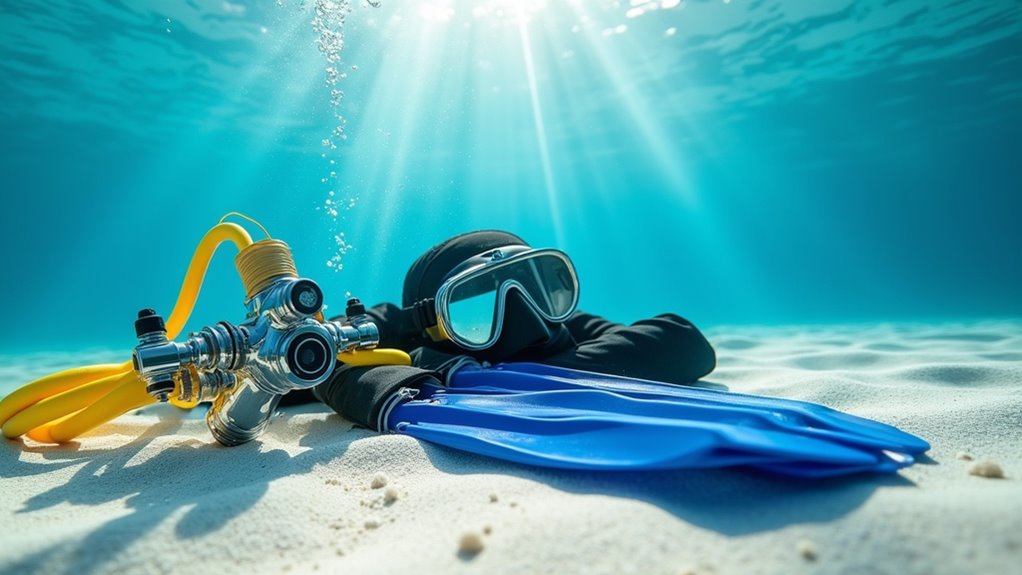
Learn essential scuba gear selection secrets that transform ordinary dives into extraordinary underwater adventures—but choosing wrong could ruin everything.
Have you ever wondered what separates a memorable underwater adventure from a disappointing dive? Your scuba equipment makes all the difference between confidently exploring vibrant coral reefs and struggling with uncomfortable, unreliable gear. You’ll need more than just basic knowledge to choose the right regulators, masks, and thermal protection that match your diving style. The ocean’s most breathtaking secrets await, but only if you’re properly equipped to handle what lies beneath the surface.
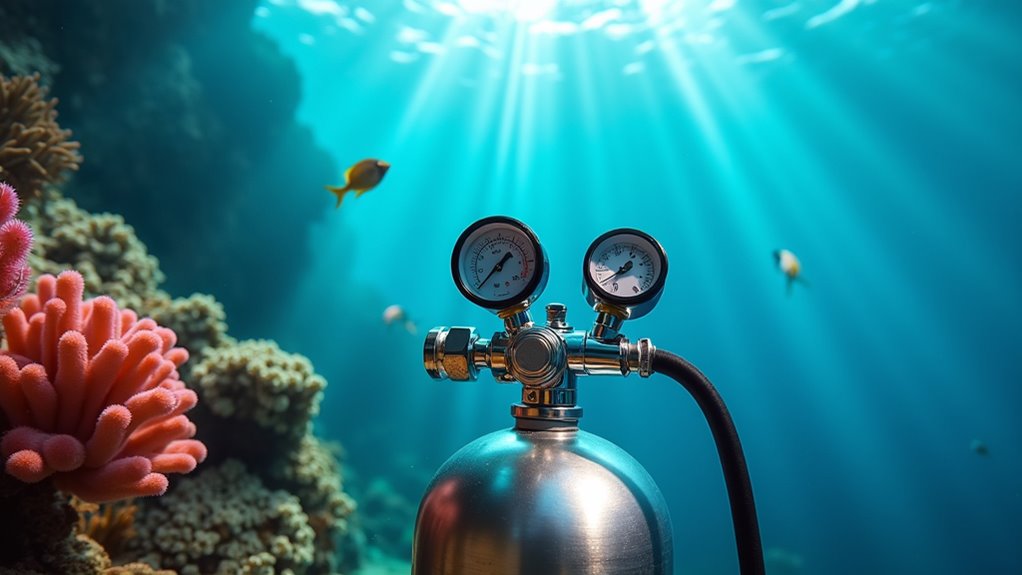
Two critical components keep you alive underwater: your regulator and air tank work together as your personal life support system. Your regulator’s first stage connects directly to your tank, reducing high-pressure air to an intermediate pressure. The second stage delivers breathable air on demand when you inhale.
You’ll typically use aluminum or steel tanks, with aluminum being lighter and more buoyant. Steel tanks hold more air but weigh more on land. Most recreational divers use tanks ranging from 63 to 120 cubic feet capacity.
Your regulator system includes a primary second stage for normal breathing and an alternate air source for emergencies. Always check your air pressure gauge before diving and monitor it throughout your dive.
These components require regular professional servicing to guarantee reliable performance underwater. Proper mask clearing techniques are essential for maintaining clear vision throughout your dive, as fogged or water-filled masks can compromise safety and enjoyment.
While your breathing apparatus keeps you alive, your mask, snorkel, and fins form the foundation of your underwater mobility and vision.
Your mask creates an air pocket that lets you see clearly underwater. Choose one with tempered glass lenses and a comfortable silicone skirt that seals against your face without pinching. You’ll need to clear water from it occasionally, so practice the technique beforehand.
Fins transform your legs into powerful propulsion systems. Longer fins provide more thrust but require stronger leg muscles, while shorter fins offer better maneuverability in tight spaces.
Your snorkel serves as backup surface breathing equipment and conserves tank air during surface swimming.
If you’re exploring deeper waters for fishing adventures, consider whether renting equipment initially makes more financial sense than purchasing everything outright.
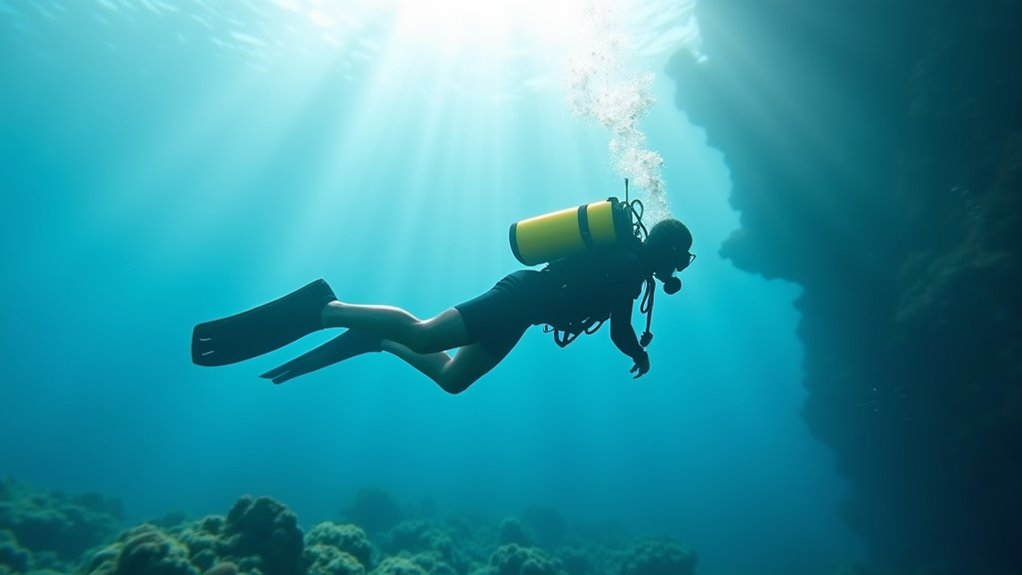
Once you’ve mastered basic vision and propulsion, your buoyancy control device (BCD) becomes the most essential piece of equipment for safe, enjoyable diving. This inflatable vest controls your position in the water column by adding or releasing air.
You’ll inflate it to ascend, deflate to descend, and fine-tune for neutral buoyancy to hover effortlessly.
Your BCD connects to your tank via low-pressure inflator hose, allowing instant air additions with the push of a button. Manual deflation occurs through dump valves on your shoulder or lower back.
Quality BCDs feature multiple pockets for accessories, integrated weight systems, and comfortable padding.
Master your BCD, and you’ll glide through underwater environments like you’re flying—controlling depth precisely while conserving energy and protecting delicate marine life. Proper preparation with your BCD skills is crucial for creating memorable scuba experiences during your diving vacation.
Water steals body heat twenty-five times faster than air, making thermal protection your lifeline in most diving environments. You’ll need the right exposure suit to maintain core temperature and prevent hypothermia during your underwater adventures.
Water robs heat twenty-five times faster than air, making proper thermal protection absolutely critical for safe diving adventures.
Wetsuits trap a thin layer of water between the neoprene and your skin, which your body warms to create insulation. They’re perfect for tropical and temperate waters.
Drysuits keep you completely dry with sealed seams and waterproof zippers, ideal for cold water diving.
Semi-dry suits combine features of both.
Just like divers rely on waterproof protection underwater, campers and outdoor enthusiasts benefit from waterproof sleeping bags that keep them dry and comfortable in wet conditions.

Since underwater environments strip away familiar reference points, your depth and safety instruments become essential navigation and monitoring tools that could save your life. Your depth gauge tells you exactly how deep you’ve gone, preventing dangerous rapid ascents that cause decompression sickness.
Pressure gauges monitor your air supply, showing remaining tank pressure so you won’t run out of breathing gas underwater.
Dive computers revolutionize safety by calculating no-decompression limits, tracking nitrogen absorption, and providing real-time ascent rate warnings. They’re more accurate than tables and eliminate guesswork.
Your compass ensures you’ll find your way back to the boat or shore, especially in murky water or when exploring unfamiliar sites.
Together, these instruments form your underwater safety net, transforming potentially risky dives into controlled, enjoyable adventures. Proper equipment becomes even more critical when exploring dangerous diving spots where challenging conditions demand maximum safety preparedness.
While your instruments keep you safe and oriented underwater, achieving proper buoyancy requires the right amount of weight to counteract your body’s natural tendency to float. You’ll need a reliable weight system to descend comfortably and maintain neutral buoyancy throughout your dive.
Traditional weight belts offer simplicity and quick release capability, while integrated weight systems built into BCDs provide better weight distribution and streamlined profiles. You’ll want to distribute weight evenly to maintain proper trim and avoid rolling or tilting underwater.
Just as mosquito nets are crucial protection in certain regions above water, proper weight systems serve as essential protection equipment for divers below the surface.
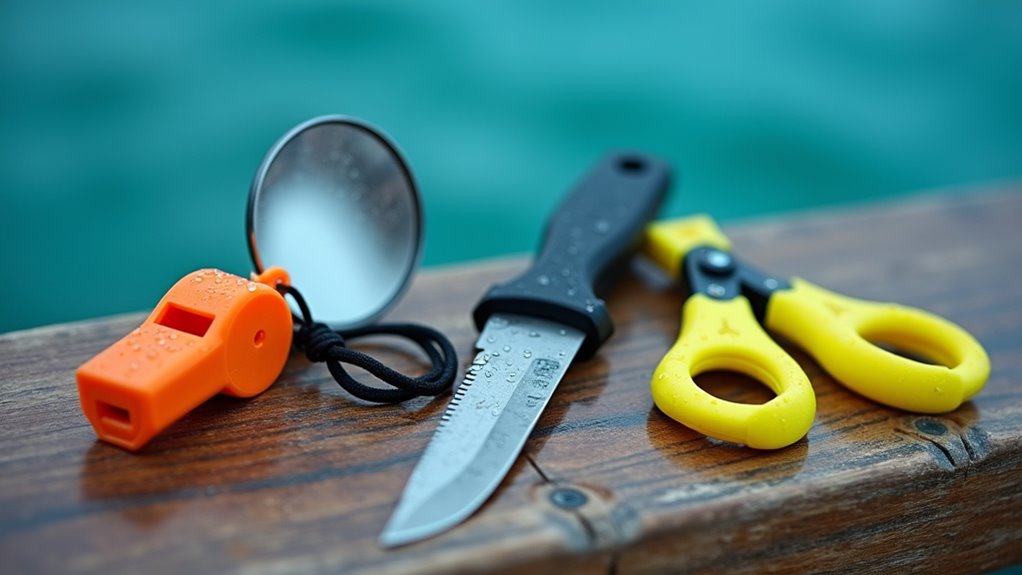
Beyond the essential gear that keeps you breathing and buoyant underwater, you’ll need reliable emergency safety equipment that can literally save your life when things go wrong.
A surface whistle‘s your first line of defense when you need to signal distress or attract attention from boats and dive buddies. Choose a bright-colored, pealess whistle that won’t fail when waterlogged.
Underwater signal devices include dive alerts that attach to your BC inflator hose, producing loud honking sounds, and signaling tubes for visual communication. Tank bangers work well for getting your buddy’s attention.
Cutting tools are essential for escaping entanglement from fishing lines, nets, or kelp. Pack a sharp dive knife or trauma shears in an easily accessible location. These tools can mean the difference between a minor inconvenience and a life-threatening emergency.
Just as family camping activities require proper safety planning and equipment preparation, scuba diving demands the same level of attention to emergency preparedness before entering the water.
Once you’ve mastered the fundamentals and logged dozens of dives, you’ll likely want to capture and illuminate the underwater world in ways that basic gear can’t achieve. Advanced underwater cameras and specialized lighting equipment transform your diving experience from simple observation to creative documentation.
Modern underwater cameras range from compact point-and-shoots in waterproof housings to professional DSLR systems. You’ll need strobes or video lights to restore colors that water filters out naturally. Red disappears first at shallow depths, making artificial lighting essential for vibrant photos and videos.
Underwater photography requires artificial lighting to restore natural colors that water absorbs, especially reds which vanish at shallow depths.
Consider these advanced gear options:
When selecting diving equipment, apply the same compact camping gear principles to ensure your underwater photography setup fits efficiently in your dive bag without compromising functionality.
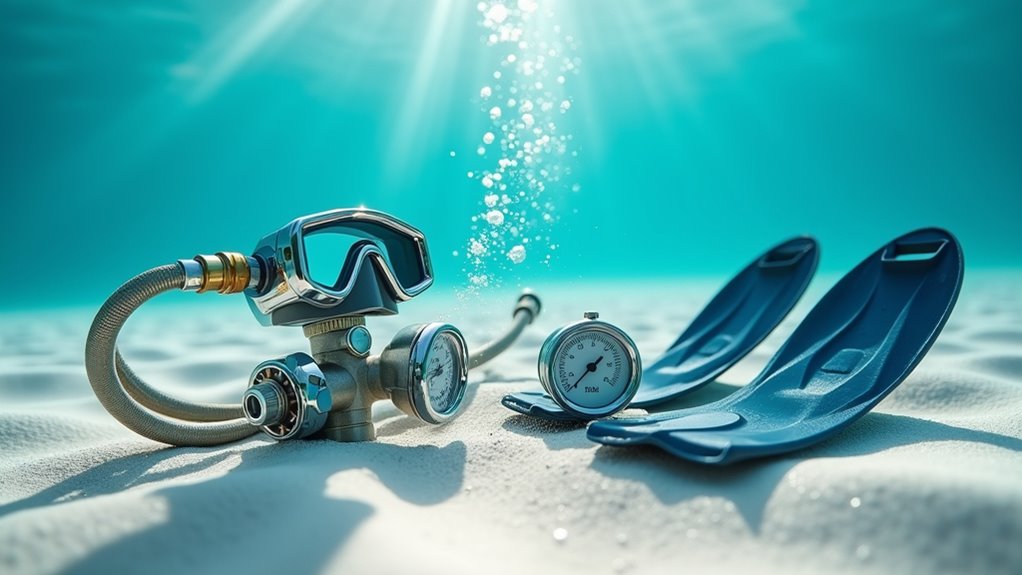
Your scuba gear represents a significant investment in both money and safety, making proper maintenance absolutely critical for every dive. After each diving session, you’ll want to rinse everything thoroughly with fresh water, paying special attention to regulators and BCDs. Don’t forget to soak metal components to prevent corrosion from saltwater exposure.
Store your wetsuit on wide hangers to maintain its shape, and keep your mask and fins away from direct sunlight.
Your regulator needs annual professional servicing, while you can handle basic BCD maintenance yourself by checking inflator mechanisms and dump valves regularly.
Create a pre-dive inspection routine, examining hoses for cracks and testing all connections. Just as outdoor enthusiasts rely on specialized gear like the Kelty Basecamp Kitchen for their camping adventures, divers depend on quality equipment that requires consistent care and attention. Well-maintained equipment isn’t just about longevity—it’s your lifeline underwater.
When you’re starting your diving journey, the decision between buying and renting equipment can feel overwhelming, but it doesn’t have to be complicated. Your diving frequency and experience level should guide this choice.
If you’re diving occasionally or just getting certified, renting makes perfect sense. You’ll avoid large upfront costs and can try different brands.
However, once you’re diving regularly or pursuing advanced certifications, investing in your own gear becomes worthwhile.
Consider these factors when making your decision:
Just as glacier climbing requires specialized equipment suited to extreme conditions, having your own properly fitted diving gear ensures optimal performance and safety underwater.
You might think quality scuba gear’s too expensive, but remember—you’re investing in your safety and enjoyment. Start with essential items and build your collection gradually. Don’t cut corners on life-support equipment like regulators and BCDs. Whether you’re buying or renting, you’ll discover that proper equipment transforms your underwater adventures. Take care of your gear, and it’ll take care of you. Now plunge in and explore those incredible ocean depths with confidence!